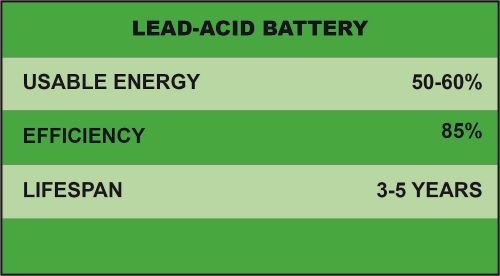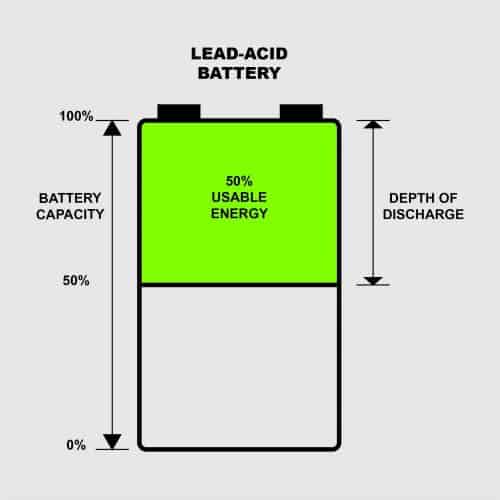Table of Contents
Lead Acid Batteries: Are They A Good Solar Battery?
Invented in 1859, lead acid batteries are the oldest rechargeable battery. First used to power train carriage lights, lead-acid is today the dominant battery used in the automotive industry.
Does this mean you can use a car battery as a solar battery? You can but car batteries are not designed for frequent charging and discharging. You will wear that battery out in a couple of months.
Lead acid solar batteries are either Flooded Lead Acid (FLA) or Sealed Lead Acid (SLA). This post is a broad introduction to lead-acid. If you want to get into specifics of each type check out this guide to flooded lead acid batteries, this one on sealed lead acid batteries, and this comparison of flooded vs sealed lead acid batteries.
Is lead-acid a good solar battery?
The main advantage lead-acid has over other types of solar batteries is the price. Lead-acid is the cheapest. Lead-acid batteries are up to 2-3 times cheaper than lithium.

Lead-acid has some drawbacks. Lead-acid batteries have a shorter cycle count, take longer to charge and deliver less energy.
If you’re shopping around for solar batteries and you’re looking at lead-acid here are some key characteristics, you need to know.
Battery capacity
Capacity is the total energy a battery holds. Batteries also have a depth of discharge. Depth of discharge is how much energy (as a percentage of the batteries total capacity) you can use.

Lead-acid has a depth of discharge of 50%. That means if you have a 100Ah battery you can use 50Ah without the risk of permanently reducing the batteries capacity. This happens when you exceed the depth of discharge.
Depth of discharge is important to know because:
- Sticking to the depth of discharge gives the battery a longer lifespan.
- Depth of discharge can determine the sizing and design of a solar energy system.
The capacity of lead-acid batteries isn’t fixed. It varies with how quickly it’s discharged. The more appliances you have, the quicker the discharge. The quicker the discharge, the lower the capacity.
Efficiency
Battery efficiency is how much energy stored you can use. If you have 100 watts coming into a lead-acid battery, you can use 85 watts. That’s because lead-acid has an efficiency of 85%.
Because they have lower efficiency, lead acid batteries charge slower. This is especially critical for an off-grid solar system in winter or on cloudy days.
Energy density
The density of a battery is how much energy per weight it holds. Lead-acid has the lowest energy density compared to other battery types.
A lower energy density makes lead acid batteries up to 50% bigger and three times heavier than lithium. Being bigger and heavier can be a problem in terms of installation if you have limited space.
Here’s a detailed comparison of lithium vs lead acid batteries if you want to know which is the better solar battery and why.
Cycle life
Batteries have a cycle life. A charge and discharge (through use) make one cycle. Lead-acid batteries have an average of 2000 cycles. You can charge + discharge them about 2000 times.
To work this out in days divide 2000 by 365. This gives lead-acid a lifespan of roughly 5 years. This is based on a one cycle per day basis while sticking to the depth of discharge.
Other characteristics
You need to know the capacity, efficiency, density and cycle life of a solar battery. There are a few other performance specifications that aren’t as critical but are still important. These are flexibility, battery maintenance, self-discharge and recycling.
Flexibility
With lead-acid, you can’t mix batteries of different ages. All the batteries, if wired together, must be bought together. The disadvantage of this is you can’t buy one battery this year then buy more as your energy needs grow or as money becomes available.
With lithium, you can mix batteries of different ages.
Maintenance
Flooded lead-acid batteries need maintenance. If you don’t want a battery that requires you to be hands on then you don’t want an FLA battery. Find out what kind of maintenance is required for flooded lead-acid batteries here.
Self-discharge
Batteries lose some energy even when they’re not connected to a load. Lead-acid has a higher rate of self-discharge (2-5%) per month than other batteries.
Recycling
Because they contain lead, lead-acid batteries are harder to recycle. The lead presents an environmental hazard if not properly disposed of.
As it’s highly toxic, this makes lead-acid battery recycling one of the world’s deadliest industrial processes.
Lead-acid battery pros and cons
To summarize everything, let’s weigh up the pros and cons of lead acid.
Pros of lead-acid
- It’s the cheapest solar battery. It can cost up to 2-3 times less than lithium batteries.
Cons
- Less depth of discharge gives you less usable energy.
- Slower charging. This is critical in winter and on cloudy days when there is less sun to charge the batteries.
- A bigger and heavier battery restricts installation options if you have limited space.
- Shorter lifespan.
- Some lead-acid batteries like FLA need maintenance.
- Limited flexibility in terms of expanding your battery bank size.
When should you choose lead acid batteries?
Lead-acid has a few disadvantages. This doesn’t mean you should break the bank to go with lithium batteries. There are certain scenarios where lead-acid will work just fine.
Off-Grid home or full-time use
For off-grid or full-time use, you can go with Flooded Lead Acid (FLA) as long as you don’t mind the maintenance.
For a 2nd home or residence, you don’t use as much, Sealed Lead Acid (SLA) is perfect. They don’t need maintenance and won’t die if left idle for long periods.
Battery backup
If you’re just worried about blackouts or load shedding and you need backup power you want Sealed Lead-Acid (SLA). Lithium might be expensive if you’re barely going to use them and FLA requires too much maintenance.
Lead acid battery FAQs
How much does a lead acid battery cost?
Depending on size lead-acid batteries cost anywhere between USD250 to USD500 in Zimbabwe.
How long does a lead acid battery last?
A lithium battery lasts 5+ years if you stick to the recommended depth of discharge.